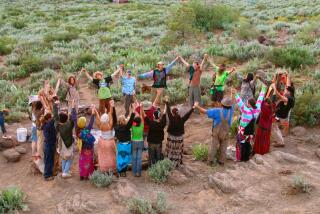SOVIET ARTS FESTIVAL : Tourists May BE the Traps, FBI Warns
- Share via
As city officials open their arms to the largest number of Soviet tourists ever to visit San Diego, FBI officials are shaking their heads and urging caution.
In an unusual public appeal, the bureau is warning San Diegans that their contacts with visiting Russians may be used by “skilled intelligence officers” for espionage.
“Every San Diego citizen should be a good host to visitors but should also be alert. If activity is observed which appears to be outside the normal tourist activity, the FBI should be contacted,” according to an FBI statement prepared for a news conference this morning.
During the next two weeks alone, more than 300 Russians will arrive for San Diego’s Soviet arts festival, which begins Oct. 21. City officials say they are making every effort to welcome the visitors, but the FBI warns that spies could easily prowl the city, using the festival hoopla to veil their activities and dupe unwitting citizens into revealing more than they ought. FBI officials point to 13 proven cases of espionage in the past three years that have blemished the nation’s security.
During 1987, the U. S. State Department granted 12,000 Soviet tourist visas nationwide. In 1988, the number jumped to 27,500, and this year officials estimate that the number will increase to more than 60,000 visas.
“The increase in visitors coming to San Diego is proportionately similar,” the FBI statement says.
FBI officials declined to comment on the statement, saying they will discuss it in greater detail at today’s news conference.
“This increased contact between San Diego residents and Soviet citizens is both good and bad,” the statement says. “There is, however, the possibility that these contacts will be used by skilled intelligence officers for other purposes. Experience shows such has occurred in the past, and wisdom suggests it will happen in the future.”
City officials say residents have responded to the Soviet visitors with hospitality. Some have offered their homes; others said they would cook dinners. More than 100,000 tickets to the festival have already been sold.
Mayor Maureen O’Connor, the leading proponent of the festival, could not be reached for comment Wednesday. Her spokesman, Paul Downey, said: “We really don’t see any problems at all; we are doing this with the total blessing of the U.S. government. From our standpoint, everybody who is coming from the Soviet Union is connected with the arts. I think everybody coming is who they say they are.”
Local military officials declined to discuss whether they will increase security, as the FBI is doing.
“The military is not going to change its posture,” said Cmdr. Doug Schamp, a Navy spokesman. “If the Soviet Union wanted to get someone to San Diego, it’s not impossible, and they don’t need a festival to do it.”
As the warmth of glasnost trickles down to the military, officials are sending mixed signals. Although they now welcome top-ranking Soviet officials--including the Soviet defense minister--to visit local military bases, they are admonished not to be overly friendly. Since 1988, all Navy personnel have been required to report “any form of contact, intentional or unintentional” with anyone from a list of designated countries, which includes the Soviet Union, China, Cambodia, Iran, Romania and Albania.
Agents at the Naval Investigative Services in Washington have warned officers to watch for unusual signs among personnel such as “unexplained affluence, exotic vacations, things out of the ordinary like working late and excessive amounts of time spent copying things,” according to the Navy Times.
The NIS recently set up a nationwide espionage hot line for Navy personnel to call if they suspect espionage. (The number is 1-800-543-NAVY.) And, to raise sensitivity to the spy-threat, it has issued a 36-page booklet titled “Espionage.” The booklet’s cover consists of photographs of Navy personnel who were convicted on espionage charges from 1962 to 1989.
More to Read
Sign up for Essential California
The most important California stories and recommendations in your inbox every morning.
You may occasionally receive promotional content from the Los Angeles Times.










